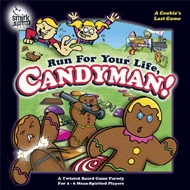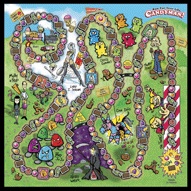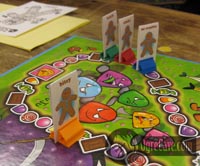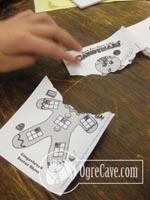
|
About OgreCave and its staff
|

|
by Allan "Sven" Sugarbaker
This review was originally posted at Game Cryer, where I serve as editor. I've made slight revisions to this version, and added pretty pictures. "Run, run, as fast as you can. You can't catch me, I'm the Gingerbread Man." Most of us heard these words at least once growing up, and may have had the passing thought that the cookie character looked rather tasty. In Run For Your Life, Candyman! the frosting shoe is on the other foot, as 2-6 players race through an enchanted candy landscape as gingerbread men, trying to flee those who would devour them. As they flee the candy kingdom, each player tracks the damage dealt to him by other players, using the supplied status sheets to mark hits taken on each body location. The winner is either the first gingerbread man to escape the board, or the last cookie left standing, whichever comes first.
Ingredients Most gamers, or even casual game players that rarely touch a game board, know what the Candy Land board looks like: a track of colored spaces in a repeating pattern, that winds its way around and through a country filled with candy-themed locations. A deck of cards determines movement, each showing the colored space (or spaces, in the case of doubles) to move to. A couple of short cuts allow kids with just the right lucky card to jump ahead, but being in the lead in Candy Land is such a transient state it's hardly worth celebrating. Here's where the problems start. The card deck contains a card corresponding to each special board location, and merely drawing one of these will send the active player forward or back on the path to that spot, magnifying the game's random nature. Worse yet, these location cards are recycled when the deck gets reshuffled, allowing the magnified random movement of the game to be repeated endlessly. Thus the momentary thrill of "I'm about to win!" becomes "Please, please, please let someone win and end this torture!" More often than not, adults, who extol the virtues of playing fair, will distract their impressionable children for long enough to rearrange the cards and make someone win ASAP, just to be done with it.
One look at the Run For Your Life, Candyman! game board will reveal the twisted, deliciously vicious nature of this parody. The "candy castle" that represents the final space in Candy Land is merely a film prop here, hiding the king's candy factory behind it. The special board locations are marked by the foul candy-eating foes that lurk there, including the dominatrix-like Lady I. Scream, the Grisly Gummies, and Molly and Pop, a too-quiet-looking father and daughter holding rather large weapons. The game certainly looks enjoyable, and not at all aimed at preschoolers – the game box cover shows a grand melee of cookie carnage, complete with bazooka and dismembered baked goods. This carnage is the game's best feature.
That's how the cookie rumbles
A couple spaces on the board are Candy Cage Match spaces, where the real beatings take place. A player that lands on one of these spaces, or is directed to one by a card, can summon any other player to come join him there and begin exchanging attacks, blow for blow, until a candy matching that space is drawn. If another Candy Cage Match card is drawn during the Cage Match, a third player can be pulled into the brawl. Special Treat cards can't be used during these epic candy ass-kickings, but players will hardly miss them in the frantic exchange of damage. The last nine spaces on the board are marked as the table of the Twins – two ravenous sugar fiends in the guise of school children. Any gingerbread man in this zone will be attacked four times at the start of each turn as the Twins try to devour him. If a player can survive these attacks and get past the Twins' table, he wins the game. So, if being the last cookie standing doesn't look feasible, making a run for it could work – or you could end up as dessert. The rules aren't completely clear in all situations. For example, if a gingerbread victim's head is already destroyed, does another hit to the location do nothing, go to the next nearest spot, or require a redraw? However, any group of players willing to sit down and pummel some crumb-covered combatants could easily decide to houserule the situation and keep the chaos going.
Conclusions
|
||||
 Run For Your Life, Candyman!
Run For Your Life, Candyman! Make no mistake – this game is
Make no mistake – this game is 
